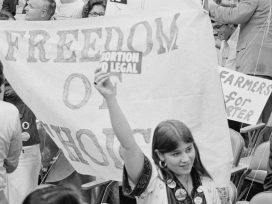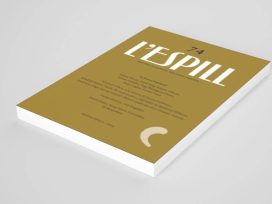Beware cartoon characters. Sex between the Simpsons, those bright yellow, four-fingered drawings, has just set a new standard for child pornography law and social absurdity. Or to put it another way, on 8 December 2008, a court in New South Wales decided that pictures are more powerful than we ever realised, when a judge ruled that an online version of The Simpsons was child pornography.
Art and child pornography law have been set on a collision course since the eighties. Until then, censorship laws in most western countries were on the decline. A growing cult of the child, however, reversed the trend. And that was in the era of analogue imagery. During the last decade, as digital technology has transformed visual communication, the conflict between art and law has only grown worse.
You will date yourself if you can remember the fateful year in which a 15-year-old Brooke Shields murmured hoarsely that nothing came between her and her Calvin Klein jeans, while a lushly coloured photograph solicited your lust for the shape of a child-woman (1980). In the following years, legal landmarks including the United States Meese Commission, (Attorney General’s Commission on Pornography, 1986) the 1989 case Massachusetts v. Oakes, the 1991-94 case Knox v. the United States, and the 1996 Child Pornography Prevention Act declared an escalating definition of obscenity where children were concerned. In England, Wales, Scotland and Ireland, the trend and chronology was much the same. Important British legal markers included: the 1978 Protection of Children Act, the 1994 Criminal Justice and Public Order Act, c.33 & 84, and the 2000 Criminal Justice and Court Service Act, c.43, & 41.
The stricter the laws became, the more difficult interpretation proved. What exactly does “naked” mean? Upon consideration, some clothing appeared as “obscene” as nudity. Where does the “genital area” begin? Somewhere high on the thigh? What is “prurient”? When does a child behave “naturally” and when does a child display an “unnatural” pose, costume, facial expression or glance? Are any of these “obvious”? If so, who has the right to decide? One photo developer? One judge? One self-appointed “child-rights activist”? Is one person’s opinion all that needs to matter?
Pictures intended to arouse a desire to have sex with children certainly do exist. Since when have all the polymorphous possibilities of sexual arousal not been represented? If prostitution is the oldest profession in the world, sex may be the oldest artistic subject – whether you call it fertility rites, erotica or pornography. The ones about children are sometimes of explicit acts of copulation, but rarely. Most of them depend heavily on innuendo, accessories, settings, labels or voice-overs.
What seems sexual in one context will not necessarily seem sexual in another. Japanese representations of children in popular culture, for example, were very different from those in Europe and North America until the end of the twentieth century. Adult social codes of sexuality reign supreme in any context. Take lipstick, for example. Sarah Palin, accepting the nomination to be vice president of the United States, infamously amused us by asking: what is the difference between a hockey mom and a pitbull? Such is the power of lipstick that it can also be all it takes to make the difference in a photograph between what we perceive to be innocent and what we perceive to be sexual, especially if the lipstick is worn by a girl. Yet there is nothing inherently sexual about lipstick. It is a sign of sexuality on which we have to agree to make it mean anything. Contrary to what hopeful censors would have us believe, the overwhelming majority of pictures of children, clothed or unclothed, are ambiguous. Sexuality is very much in the eye of the beholder.
Yet despite the subjectivity of virtually all interpretation, child pornography law persists in attacking pictures, rather than in pursuing cases of actual abuse against real children. If you can prove that a photograph was made by forcing a real child to commit a physical sexual act in front of the camera, then by all means hunt down and prosecute the adults involved in those acts. Pictures could be used instrumentally as evidence, instead of becoming the crimes themselves. Prosecute actions. Let the pictures go.
What did become increasingly clear about pictures in the last quarter of the twentieth century was that the new censorship only affected them. More particularly, it was all about the reality effect of photography. (Thanks to Roland Barthes for naming that concept.) Among pictures, the law claimed, only photographs are of or about real people and have real effects on real people. Law after law declared a trenchant distinction between the puny persuasions of the verbal and the impact of visual presence. This kind of flattery artists could do without.
Art had indeed been turning toward the subject of children, or childhood, and in undeniably provocative ways. For the same reasons the law turned its attention to children, so did art. Many artists turned toward intimate subjects. A growing number of post-feminist women artists, especially, were interrogating their own daily lives. Nan Goldin’s 1986 Ballad of Sexual Dependency, notably, dared to invite an audience into her bedroom and bathroom to witness the emotional saga of her drug-enhanced and genderbending private life. Feminism had urged women to understand that the personal was political. Post-feminism urged women, and some men, to make artistic careers out of the personal. Goldin was not a parent. Many of the mothers and fathers among her peers began to work the line between casual home snapshots and gallery exhibitions, just when a broad public, backed by the law, began to police the family album.
Caught at the intersection between law and art, one studio or exhibition after another was denounced, raided, and investigated. In the United States, state laws mandated photograph developers to report suspicious cases directly to the police. Professional artists and parent photographers rarely ended up being indicted, let alone prosecuted. The humiliation of accusations, however, punished even those who were vindicated. The financial and psychological damage of ransacked studios, seized work, and vilified reputations was never compensated for.
Still art thrived. Our understanding of childhood was irrevocably changed. For those who bothered to look carefully and with an open mind at work like Sally Mann’s, childhood would never be the same again. When her book Immediate Family came out in 1992, howls of protest could not diminish its impact. Children, we were reminded, live in their bodies, with sometimes fierce passion. They are not always cute. They are often staggeringly, heartbreakingly, beautiful. Nor is the gaze a parent turns on his or her child always soft and cuddly. Parents, we learned from the best photographs of the eighties and nineties, can look on their children with intense pride, longing, anger, resentment, and intelligence. Every trite cliché about childhood came under scrutiny. Few survived intact.
Besides the drama of its content, the form of Mann’s work was also an epitome of analogue photographic technique. She used camera equipment which gave her an expressive range of focus and negatives with exceptional tonal subtlety. Her black and white prints, which she made herself, were each unique and gorgeously dense. For galleries and museums, she made prints on a public scale, but for collectors she made prints you could hold in your hands and look at intimately. Everything about her technique contributed to the individual presence of her work. Her photographs convince you utterly that someone real had to have been in front of her camera, doing what her camera caught on its lens. It was the effect of being there that child pornography law ascribed to all photography, only more so.
All those certainties dissolved with the advent of digital technology. Or at least they did for artists. Embracing the technical possibilities offered by computers, image alteration software, and commercial colour printers, a new generation of ambitious photographers turned away from an analogue style toward a digital aesthetic. Fundamentally, the realisation that photographs would henceforward be composed of tiny bits of binary information, any or all of which could be manipulated, edited, and recombined, made photography more like a traditional artistic medium than it had ever been. Photography became the new painting. Huge in scale, lushly coloured, complexly composed, and allusively referential, if not enigmatically narrative, photography pushed theatricality into the next millennium. Regardless of whether or not younger photographers actually used digital techniques, occasionally or exclusively, their way of perceiving and expressing the world had been transformed.
In 1999, a Manhattan gallery exhibition titled Another Girl Another Planet burst 13 very young women onto the art scene to show how a rising generation would carry onward work like Goldin’s and Mann’s. Exploring the new digitally inspired aesthetic, they and other young photographers, like Anna Gaskell, Rineke Dijkstra, and Loretta Lux, during the very late 1990s and early 2000s, rethought the subject of childhood once again. They had the technical means to explore the imaginary worlds of children, our memories of childhood, and the fantasies we have about childhood. Set free from the present analogue moment, they sampled old classics from children’s literature as well as canonical images of children in the history of all visual media.
Art, one might have thought, had pulled photography away from the reach of censorship law. But no. In England, the law moved quickly, by 1994, to invent what it called the “pseudo-photograph” to justify treating images whose making had manifestly not involved any real children in the same way as those that had. United States law at first seemed to attempt a logical distinction between pictures that proved an actual child had been sexually exploited and those that did not. Reversing a 20-year trend, Ashcroft v. the Free Speech Coalition (2002) rejected the claim that the legal category of child pornography should include all pictures of children (overturning the Child Pornography Prevention Act of 1996), regardless of how they had been made and whether or not any real children had been involved in their making. The Unites States Supreme Court ruled, instead, that digitally artificial images were not subject to censorship laws, because they did not document any actual child abuse. This move was quickly countered on the legislative side of government with the Protect Act of 2003. On both sides of the Atlantic, law-makers made increasingly hair-splitting semantic attempts to salvage the possibility of convictions for child pornography, in the English Regina v. Bowden in 2001 (11 Crim. App. R. 438) for instance. The political points to be scored are just too tempting.
To be fair, the Internet has magnified fears about images of children. Its uncontrollable scale and speed have made the tiniest number of original images a potential torrent of obscenity. Adults know that children use the Internet, better and more secretly than they do, which makes them all the more protective. Yet, for the same reasons, policing the entire Internet may never be possible. Law-makers are certainly trying. In England, downloading images has become the same as “making” them. In the United States, pretending to sell child pornography is now the same as doing it. The link between real children and child pornography becomes ever more tenuous, while the desire to protect real children by stamping out child pornography becomes ever greater.
So the scandals continued. In 2001, photographs by Tierney Gieron exhibited at the Saatchi gallery in London caused a tabloid sensation; in 2004, the Spitz Gallery, also in London, removed Betsy Schneider’s photographs of her naked five-year-old daughter. More recently, in May 2008, it was the turn of Bill Henson at the Roslyn Oxley9 gallery in Australia. The prime minister got his chance to call some photographs “revolting”, and the usual arguments were made. Henson’s controversial photographs, which are very professionally staged and crafted, typically represent beautiful and noticeably adolescent bodies emerging into soft light from surrounding shadow. Like many photographers who work on the subject of adolescence, Henson is particularly fascinated by the ambiguities of a time which is neither childhood nor adulthood. Unfortunately for all of them, adolescence is legally defined as a part of childhood. The very ambiguity which attracts artists is inimical to a legal system that fortifies borders. Henson’s defenders enlisted his “artistic” intentions, the overall patterns of his subjects, and the institutional prestige of his collectors. Henson’s opponents enlisted the specious pomposity of “artistic” intentions, the exposure of genitals in the specific photos under attack, and community standards of decency.
And now we come at last to the cartoon characters Bart, Maggie and Lisa Simpson. Some fool altered those ironic, bright yellow, four-fingered creatures, to add genitals and draw them having sex with each other. By putting the animated cartoons on his computer, he gave Australian law the opportunity to set a new standard for child pornography law and social absurdity. In December 2008, in McEwen v. Simmons & Anor, Supreme Court Judge Adams engaged in some of the most tortuous reasoning child pornography law has yet produced. He did start by acknowledging that there is a “fundamental difference in kind between a depiction of an actual person and the depiction of an imaginary person”. In the end, however, he decided that if it’s “about a person”, it is a person. Where that logic could lead, I leave you to ponder. To give Adams his due, the judge, at heart, was much less concerned about theories of representation than about the spectre of harm to real children. As in all child pornography cases, his underlying fear was that no freedom of speech is worth even the slightest or most hypothetical risk of any sexual abuse of any real child. According to the impulse, if there is any chance whatsoever that anything remotely resembling what anyone anywhere could call child pornography would “fuel demand for material that does involve the abuse of children”, then it should be illegal.
What decent person could argue with that? Childhood innocence has become a talisman adults hold up against all evil, doubt and despair. No – not all childhood innocence – only childhood sexual innocence. In Canadian law, images of children having any kind of physical harm done to them are treated in the same way as child pornography, but this is an exception. In the secular West, the ideal of childhood sexual innocence has become sacred. It cannot be questioned in any way, shape or form. In such a climate, who would dare to openly make pictures that involve children’s or adolescents’ bodies or their sexuality at all?
Some artists do. The art that has got into trouble, like Henson’s, may not be the right test cases. To see whether art produces anything that makes free speech worth while, you have to look at something rather more difficult than Henson’s work. Moody dark shadows do not automatically deepen an idea. Nor are the most thoughtful photographs about childhood necessarily nudes, even when they ask us to think about children’s sexuality. Freedom of speech tolerates its margins in order to guarantee its vital centre.
Take for example a 2004 photograph by Catherine Opie titled Oliver in a Tutu. On a purely formal level, the photograph is a typical digital-era image. At 24 20 inches, it is clearly meant for public consumption. The reminder on the label that the print is one of an edition of only five is a final clue that this is not a spontaneous family snapshot. Despite the home scene, with all its clutter and easily recognisable bits of domestic architecture in the background, Opie had to be determined to show the public her subject. Oliver in a Tutu? Panic! Boys aren’t supposed to wear tutus, especially not pink ones! Is he queer? What kind of a parent would exhibit her boy in a tutu? Oh my God, Catherine Opie must be queer! Actually she is a lesbian! She must be making her child queer! Calm down, keep looking. The child is happy and safe. He looks healthy and smart. Besides the tutu, he’s wearing a very gender-neutral T-shirt. He’s just playing. It’s just a costume. And come to think of it, so what if the mother-photographer is a lesbian and the boy is dressed like a girl, as long as, the fiction of the picture reassures us, they live together in a quiet, sunny, beautifully colourful home, looking at each other with trust in their eyes?
While you’re at it, compare in your mind’s eye Oliver in his tutu with the countless images in our mainstream media and family albums of little girls prancing around in tutus, tights and leotards. Or in bikinis for that matter, or in shirts up to their chests and pants down past their navels. Is it true that child pornography is the only kind of picture in our culture that sexualises children, girls much more than boys? What girl or boy is not influenced by those ordinary images to try out adult roles (complete with lipstick)? If the sexualisation of children is what shocks us about child pornography, then let us appraise the images of children we consider to be normal more carefully. If it is the objectification of children that shocks us about child pornography, then let us consider cute again. Is cute sometimes condescending? Is miniature sometimes objectified?
Rineke Dijkstra asks those questions in her many photographs of children and adolescents. The intense optical saturation of her prints, which we may only register at an unconscious level, reinforces the more obvious effect of the large surface area of the prints. In most of Dijkstra’s photographs, the figure stands full-length, centered, looking directly at us. In real space, in a gallery, you cannot easily ignore or brush past Dijkstra’s children; they have to be reckoned with. In many of her photographs, moreover, Dijkstra has chosen a space for her figure to occupy whose lines or forms extend toward our space, suggesting her figures, though alone within their pictorial space, also belong in our world.
Dijkstra is perhaps best known for her portraits of children and adolescents posed on beaches in swimsuits. While the obvious association is the traditional one of children with nature (the exposed body on a beach, standing against the sky), in a subtle way the swimsuits do the opposite, by summoning a range of social and photographic associations: with snapshots of children on vacation (signs of leisure as well as physical well-being), with advertisements for swimsuits, with glamour photographs of adult women bathing beauties or adult muscle-men. Try this mental exercise. Compare Dijkstra’s photograph with those types of conventional photographs. They just don’t quite match. At a simple level, hers are not cute or glamorous. She has declined to choose conventionally pretty children over which our gaze would glide and instead snags our attention with the latent beauty in ordinary, quirky children and adolescents. By contrast, conventional swimsuit pictures expose children’s bodies to give us simple pleasures justified by a costume, while hers demand something more complicated, offering us the physical presence of children while making us think about it in difficult ways.
Or consider this. There is absolutely no conclusive, experimentally scientific proof that what is called child pornography causes any significant incidence of actual child abuse, whereas convicted child abusers, when asked if any images incited them, will often describe swimsuit catalogues. (Even there, however, a cause and effect scenario is dubious. Child abusers seem perfectly capable of doing without any pictures at all.) Dijkstra’s photographs would not do the trick. Art like Opie’s and Dijkstra’s call into question the self-congratulatory assumptions on which child pornography law is predicated.
Maybe we could do without even the best art about childhood. Maybe we could ask ourselves the questions art asks on our own. But child pornography law does something worse than chill artistic thought. It allows us to ignore what actually abuses children all the time. Strangely, every single one of the scandals about child pornography in art galleries has involved photographs of healthy and affluent white children. Protection of the most vulnerable children, apparently, is not what concerns advocates of child pornography law. Rational protection of real children against actual abuse is not the highest priority of those who demand censorship of pictures. I almost wonder if it is the contrary. Is a strident demand for censorship of images a decoy? Does it deflect the facts of child abuse, the fact, for instance, that the overwhelming majority of cases of child abuse occur in the home and are inflicted by fathers, step-fathers or boyfriends?
Economists believe in a concept called revealed preference. Don’t pay attention to what I say, the concept teaches, pay attention to what I’ve done. According to the revealed preference of our laws and budgets, we care more about pictures than about people. How can we justify spending precious resources on the gargantuan yet futile surveillance of the Internet when we claim to have none for the simplest social programmes that protect and shelter children from abuse where it is most likely to happen? How can we have the resources for endless expensive law cases about pictures when we supposedly don’t have enough to pay for social workers, health care, preschools or after-schools?
As with all so-called sexual crimes against adults, the real issue is the way in which sex can be turned into a form of power. If we fixate, not even on the most convoluted and indirect definition of sexual abuse against children, but on fictional representations of that convoluted and indirect definition of sexual abuse against children, then we will not confront the most horrible ways in which we systematically abuse our power over children. The purpose of child pornography law is to protect children. The effect of child pornography laws ultimately hurts children.






